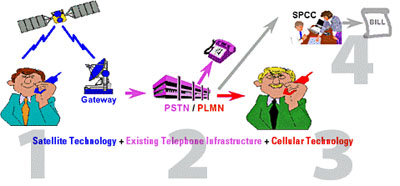|
|
 |
Knowledge Is Key
For Intelligent Decisions
Satellite Logic is a leading,
authoritative source of information in
the Satellite Industry. Located in the
heart of the Silicon Valley, Satellite
Logic provides one of the most
valuable and comprehensive
knowledge bases on the Satellite
market! This is a primary Worldwide
information center which enables our
clients to analyze, evaluate, inquire
and select their best tailored
solutions. Our company sets the
industry standards for targeted
buying leads, reflecting a dramatic
advance over traditional marketing
solutions.
|
|
|
 |

Satellite phones allow us to have voice and data communication for
instances in which the local landline and the cellular systems are
disrupted or not available. Unlike cellular phones, satellite phones do
not make use of the call towers, they use Low Earth Orbiting Satellites.
The moment you turn on your satellite phone, it will immediately
connect with any number of compatible satellites.
Let's have a look at the operation of a Globalstar Satellite Phone Call.
First a caller uses Globalstar mode to place a call via the satellite to
one or more Gateways. The Gateway routes the call to the existing
phone network, in the case indicated below, a cellular Public Land
Mobile Network (PLMN) network. The PLMN routes the call to the
intended receiver. The call is completed! The call duration, service
used, and service area are reported to the Service Provider for billing.
Now let's compare a call made via satellite vs. cellular. A subscriber
in Russia is calling her friend in San Francisco on her Globalstar satellite
phone. Her signal is handled by a passing satellite. The satellite relays
the call to a Gateway in its footprint. The Gateway converts the signal
to work with the local PSTN and passes on the call. Depending on the
distance between the callers, a Globalstar satellite call might pass
through several Gateways and PSTNs before locating the receiving
phone. The PSTN uses the call's routing information to connect to
another Gateway that knows where the receiving phone is located.
The Gateway located closest to the receiving phone converts the
signal to Globalstar format and uplinks it to a satellite. This Gateway
knows that the receiving phone is in its contact area because an earlier
satellite relayed that phone's power-on registration message to the
Gateway. This information was stored in the Gateway's Visitor Location
Register (VLR). The call is relayed to the receiving phone and the call
linkage is complete!
The Globalstar constellation consists of 48 LEO (low-Earth-orbiting)
satellites, plus an additional four satellites in orbit as spares. Each
consists of an antenna, a trapezoidal body, two solar arrays and a
magnetometer, and operates at an altitude of 1414km (876 miles).
The satellites are placed in eight orbital planes of six satellites each,
inclined at 52 degrees to provide service on Earth from 70 degrees
North latitude to 70 degrees South. Because of this configuration, the
polar regions, including most of Greenland, small parts of Alaska,
Canada, Scandinavia, Siberia, and regions in the Southern
Hemisphere, including Antarctica and parts of South America are not
covered.

The Globalstar constellation of satellites can pick up signals from over
80% of the Earth's surface. Several satellites pick up a call, and this
"path diversity" assures that the call does not get dropped even if a
phone moves out of sight of one of the satellites. If buildings or terrain
block your phone signal, a "soft-handover" takes place, and the call's
transmission is switched to an alternate satellite with no interruption.
This satellite now maintains transmission of the original signal to one of
several terrestrial Globalstar Gateways. Because all the switches and
complex hardware are located on the ground in the Gateways,
Globalstar satellites are relatively simplistic, leading to dramatically
increased system reliability.
Additional advantages of using low-Earth-orbiting satellites include
lighter, smaller, all-in-one handsets and no perceptible voice delay.
LEO satellites also minimize call transmission time delays. Long
transmission delays cause noticeable gaps between the time a caller
speaks and when the listener hears what is being said. The satellite
coverage beams for satellite phone communication links and the
Gateway communication links are quite large.
Each footprint moves rapidly across the Earth's surface. A satellite
that passes directly overhead is visible to that spot for only about 15
minutes. When a user places a satellite call, the nearest satellite picks
up the signal. Satellite phones can operate with a single satellite in
view, though typically two to four satellites will be overhead. This
simultaneous coverage by multiple satellites is called "path diversity,"
which enhances the quality of the satellite call. Path diversity is a
method of signal reception that combines multiple signals of varying
power strengths into a single coherent signal. Satellite phones
communicate with as many as three satellites simultaneously,
combining those signals into a single, static-free signal. Satellite
phones also alter power levels to compensate for shadowing and
interference as needed. As satellites move in and out of view, they
will be seamlessly added to and removed from the calls in progress,
reducing call interruption. This enables the satellite phone system to
provide communication to a wide variety of locations with less
potential for signal blockage from buildings, terrain, or other natural
features.
Today, most of the world is NOT covered by cellular networks, whether
in wilderness areas, on long-haul trucking routes, or in developing
nations. That's why we need satellite phones, that give us the
possibility to connect almost anywhere, whether next door or half-way
around the world.
|
|
|
|
